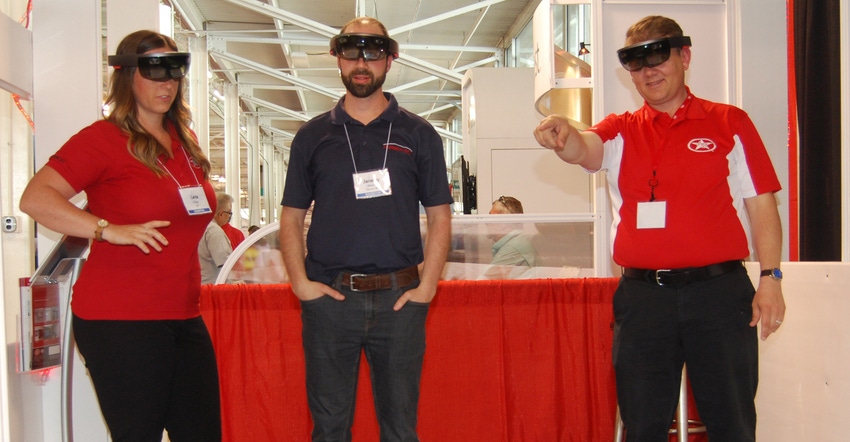June 22, 2018

Reducing exposure to airborne diseases is essential to help maintain optimal swine health and productivity. By using “mixed reality” technology, farmers attending the recent World Pork Expo in Des Moines experienced how positive-pressure ventilation systems can help prevent the infiltration of viruses in pork production.
Positive-pressure ventilation forces filtered air out of a building, reducing the risk of exposure to airborne pathogens that are more prevalent with traditional negative-pressure systems.
“This process prevents unfiltered outdoor air from entering the animal living areas that might otherwise be compromised from air leaks or open-air inlets in a negative-pressure ventilation environment,” said Brian Rieck, product manager for Automated Production Systems.
At the AP exhibit at the World Pork Expo, producers could enter a 10-by-20-foot framework wearing mixed-reality glasses that immersed the visitors in an animated, holographic demonstration of a swine barn equipped with the AP positive-pressure system. The visitors to the exhibit listened to a recorded narration that described the components of the ventilation system and how it works.
“It was the closest thing to being in a hog barn without actually being there,” Rieck says.
How a positive air pressure system works
In this system, outdoor air first enters the barn through an optional sidewall that adjusts to a barn’s air intake requirements, and then passes through filters that provide more than 95% particle capture on the most virulent particle sizes.
Airflow continues through an evaporative cooling system capable of up to a 20-degree-F temperature reduction, depending on outdoor temperature and humidity conditions, to combat seasonal heat and stress-related dips in production.
Next, the air is forced into the animal living space via ventilation fans and through tunnel doors, ceiling inlets or a combination of both, depending on circulation needs. Finally, the air is forced out of the building via wall shutters and actuated exhaust systems.
The ventilation process is connected to AP’s integrated Edge system, which enables pork producers to set, monitor and manage all the environmental functions in multiple barns or rooms from a single controller, using one interface. It automatically determines the proper inlet settings and fan stages, eliminating the need for producers to use complicated calculations to convert cubic feet per minute per head into ventilation stages.
Helps maintain healthy air quality
“Positive-pressure systems are an effective solution for maintaining healthy air quality for animals and are essential to any successful virus protection plan,” Rieck said. “By preventing the spread of harmful pathogens, positive-pressure systems provide the greatest protection of a producer’s investment against devastating swine airborne diseases.”
Two representatives of AP, Lena Head and Lance Brown, gave tours of the virtual-reality hog barn and ventilation system exhibit at the expo. One of the visitors was Jeremy Martin of Farmer Boy Ag, a livestock and poultry equipment dealer who buys technology and products from AP and works with farmers installing and servicing those products.
“The benefit of positive pressure is that hog barns don’t have to be completely sealed for the highest level of protection against viruses,” Martin says. “This style of ventilation slightly pressurizes the building, forcing the inside air out through any crack or joint.
You can learn more by contacting an AP dealer or visiting AutomatedProduction.com.
Source: Automated Production Systems
You May Also Like




